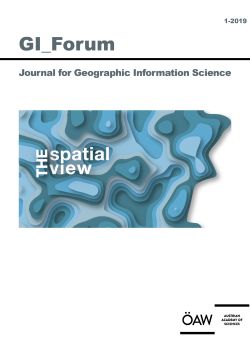Adrijana Car – Thomas Jekel – Josef Strobl – Gerald Griesebner (Eds.)
GI_Forum 2019, Volume 7, Issue 1
Journal for Geographic Information Science
Anita Graser
S. 54 - 68
doi:
10.1553/giscience2019_01_s54
Verlag der Österreichischen Akademie der Wissenschaften
doi:
10.1553/giscience2019_01_s54
Abstract:
Movement data analysis is a high-interest topic in many scientific domains. Even though Python is the scripting language of choice in the GIS world, currently there is no Python library that would enable researchers and practitioners to interact with and analyse movement data efficiently. To close this gap, we present MovingPandas, a new Python library for dealing with movement data. Its development is based on an analysis of state-of-the-art conceptual frameworks and existing implementations (in PostGIS, Hermes, and the R package trajectories). We describe how MovingPandas avoids limitations of Simple Feature-based movement data models commonly used to handle trajectories in the GIS world. Finally, we present the current state of the MovingPandas implementation and demonstrate its use in stand-alone Python scripts, as well as within the context of the desktop GIS application QGIS. This work represents the first step towards a general-purpose Python library that enables researchers and practitioners in the GIS field and beyond to handle and analyse movement data more efficiently
trajectory, spatio-temporal analysis, python, movement data analysis
Published Online:
2019/06/19 07:59:53
Object Identifier:
0xc1aa5576 0x003aba2b
Rights:https://creativecommons.org/licenses/by-nd/4.0/
GI_Forum publishes high quality original research across the transdisciplinary field of Geographic Information Science (GIScience). The journal provides a platform for dialogue among GI-Scientists and educators, technologists and critical thinkers in an ongoing effort to advance the field and ultimately contribute to the creation of an informed GISociety. Submissions concentrate on innovation in education, science, methodology and technologies in the spatial domain and their role towards a more just, ethical and sustainable science and society. GI_Forum implements the policy of open access publication after a double-blind peer review process through a highly international team of seasoned scientists for quality assurance. Special emphasis is put on actively supporting young scientists through formative reviews of their submissions. Only English language contributions are published.
Starting 2016, GI_Forum publishes two issues a Year.
Joumal Information is available at: GI-Forum
GI_Forum is listed on the Directory of Open Access Journals (DOAJ)




 Home
Home Print
Print
 References
References
 Share
Share
